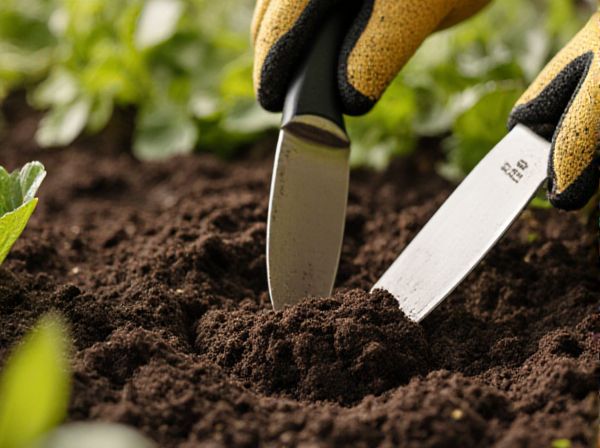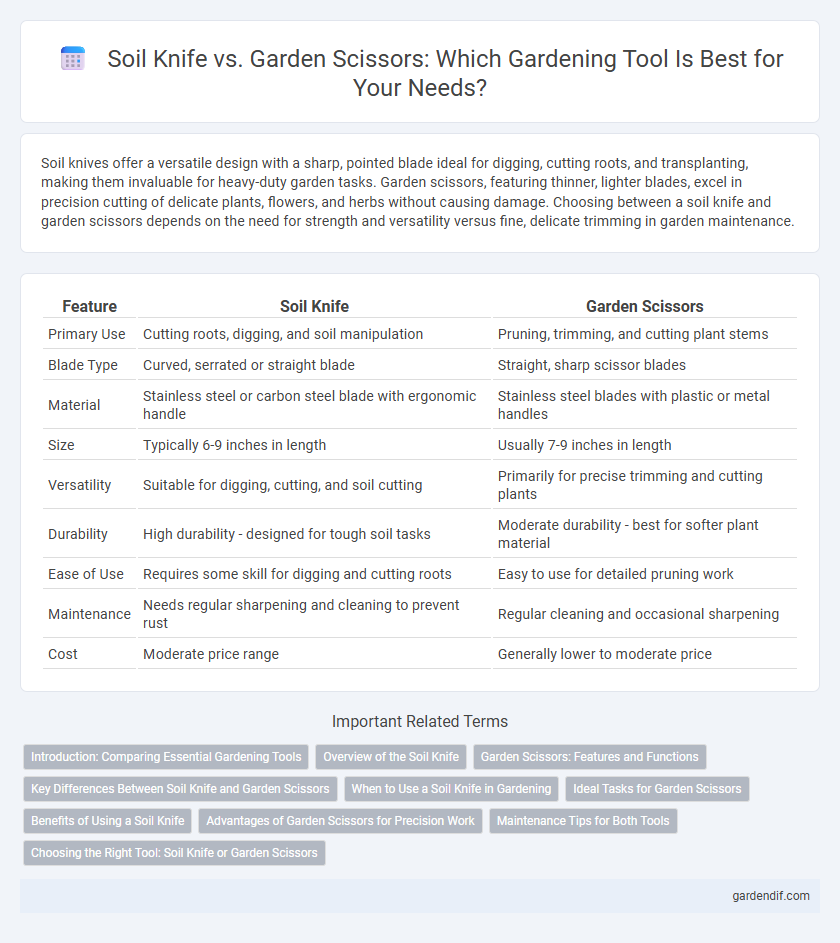
Soil Knife vs Garden Scissors Illustration
Soil knives offer a versatile design with a sharp, pointed blade ideal for digging, cutting roots, and transplanting, making them invaluable for heavy-duty garden tasks. Garden scissors, featuring thinner, lighter blades, excel in precision cutting of delicate plants, flowers, and herbs without causing damage. Choosing between a soil knife and garden scissors depends on the need for strength and versatility versus fine, delicate trimming in garden maintenance.
Table of Comparison
| Feature | Soil Knife | Garden Scissors |
|---|---|---|
| Primary Use | Cutting roots, digging, and soil manipulation | Pruning, trimming, and cutting plant stems |
| Blade Type | Curved, serrated or straight blade | Straight, sharp scissor blades |
| Material | Stainless steel or carbon steel blade with ergonomic handle | Stainless steel blades with plastic or metal handles |
| Size | Typically 6-9 inches in length | Usually 7-9 inches in length |
| Versatility | Suitable for digging, cutting, and soil cutting | Primarily for precise trimming and cutting plants |
| Durability | High durability - designed for tough soil tasks | Moderate durability - best for softer plant material |
| Ease of Use | Requires some skill for digging and cutting roots | Easy to use for detailed pruning work |
| Maintenance | Needs regular sharpening and cleaning to prevent rust | Regular cleaning and occasional sharpening |
| Cost | Moderate price range | Generally lower to moderate price |
Introduction: Comparing Essential Gardening Tools
Soil knives and garden scissors serve distinct roles in gardening, with soil knives designed for cutting through tough roots and soil, while garden scissors excel in precision trimming and pruning delicate plants. The soil knife typically features a curved, serrated blade for versatile digging and cutting tasks, enhancing efficiency in soil management. Garden scissors offer sharp, fine blades for clean cuts on flowers, herbs, and small branches, promoting healthier plant growth.
Overview of the Soil Knife
The soil knife features a robust, multipurpose blade designed for digging, cutting roots, and transplanting, making it an essential tool for gardening and landscaping tasks. Its ergonomic handle ensures comfortable grip and precise control during soil preparation and plant maintenance. Compared to garden scissors, the soil knife offers enhanced versatility for tougher soil and root work.
Garden Scissors: Features and Functions
Garden scissors feature sharp, precision blades designed for clean cuts on delicate plant stems and flowers, ensuring healthy growth without damaging the plant. They often include ergonomic handles for comfortable use during extended pruning sessions, enhancing control and reducing hand fatigue. Ideal for detailed garden tasks, garden scissors excel in trimming herbs, deadheading flowers, and maintaining small shrubs with accuracy.
Key Differences Between Soil Knife and Garden Scissors
Soil knives feature a sturdy, serrated blade designed for cutting through roots, soil, and tough garden materials, whereas garden scissors have thinner, sharper blades optimized for precision trimming of plants and flowers. Soil knives often include a pointed tip for digging and prying, while garden scissors prioritize control and clean cuts to avoid damaging delicate stems. The robust construction of soil knives supports heavy-duty tasks, contrasting with garden scissors' lightweight design intended for detailed gardening work.
When to Use a Soil Knife in Gardening
A soil knife is ideal for tasks requiring precision and toughness, such as cutting through roots, digging small holes, and dividing plants. Its serrated edge helps in slicing through tough soil and roots more efficiently than garden scissors, which are better suited for trimming delicate stems and leaves. Use a soil knife when working with dense soil or handling heavy-duty garden maintenance that demands robust cutting power.
Ideal Tasks for Garden Scissors
Garden scissors excel at precise trimming tasks such as shaping small plants, cutting flowers, and harvesting herbs, where clean cuts help maintain plant health. Their sharp, fine blades make them ideal for delicate pruning and deadheading in tight spaces. Compared to soil knives, garden scissors offer better control for detailed grooming and finishing touches in the garden.
Benefits of Using a Soil Knife
A soil knife offers versatile cutting power for gardening tasks such as slicing through roots, dividing plants, and digging small holes, making it an essential multi-purpose tool. Its robust, serrated blade excels in tackling tough soil and dense root systems, which garden scissors cannot efficiently handle. This durability and functionality streamline garden maintenance, reducing effort and increasing precision in various soil-related activities.
Advantages of Garden Scissors for Precision Work
Garden scissors offer superior precision for detailed gardening tasks, allowing for more accurate trimming of delicate plants and flowers. Their sharp, narrow blades enable clean cuts in tight spaces, minimizing damage to surrounding foliage. Ergonomically designed handles provide better control and reduce hand fatigue during intricate pruning activities.
Maintenance Tips for Both Tools
Maintaining a soil knife involves regular cleaning after use to prevent rust and ensure sharpness, requiring occasional oiling and blade sharpening with a whetstone or sharpening steel. Garden scissors benefit from cleaning sap and dirt residue with warm soapy water, followed by drying and lubricating the pivot with light machine oil to maintain smooth operation. Both tools should be stored in a dry place to avoid moisture damage and extend their lifespan.
Choosing the Right Tool: Soil Knife or Garden Scissors
Selecting the right gardening tool depends on the task: soil knives excel in cutting through roots, dividing plants, and digging, while garden scissors are designed for precise trimming and harvesting of delicate plants. Soil knives offer versatility and durability with serrated edges for tougher soil work, whereas garden scissors provide sharp, fine blades for clean cuts on stems and leaves. Choosing between the two hinges on whether your gardening needs prioritize robust digging and cutting or detailed trimming and harvesting.
Soil Knife vs Garden Scissors Infographic

 gardendif.com
gardendif.com